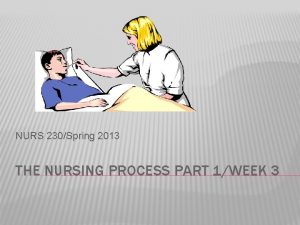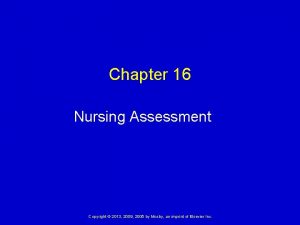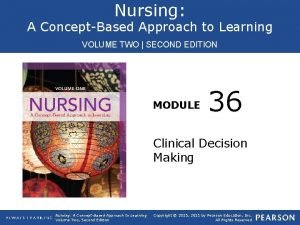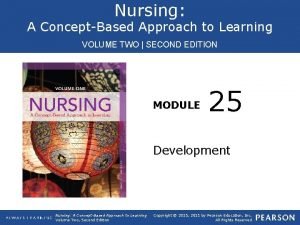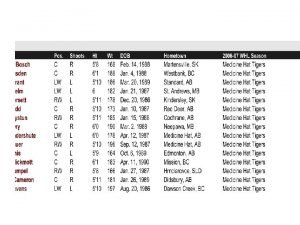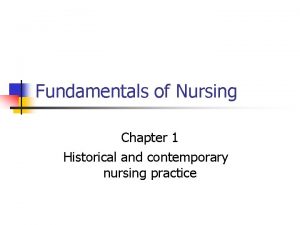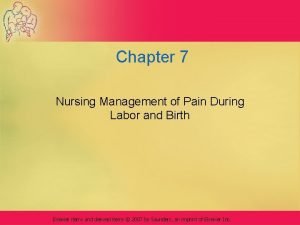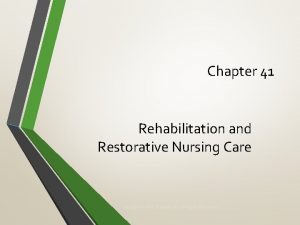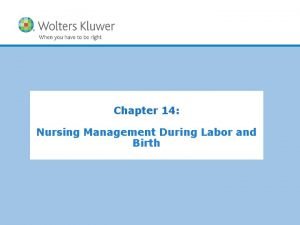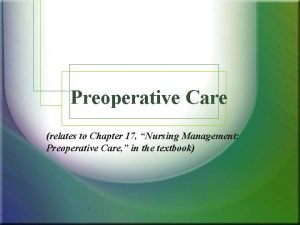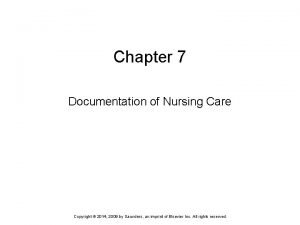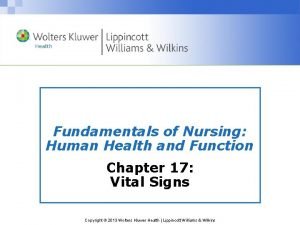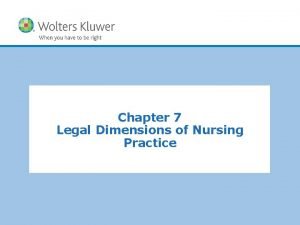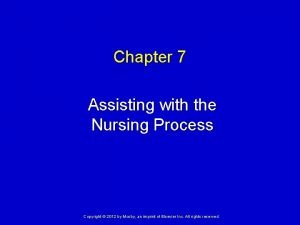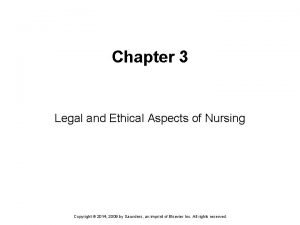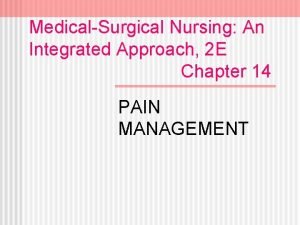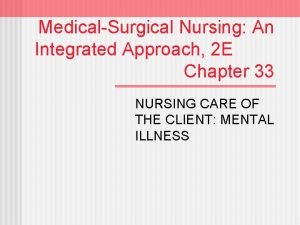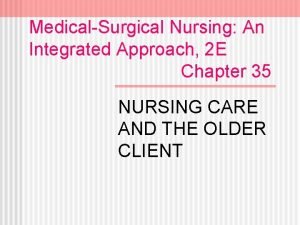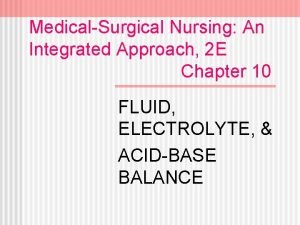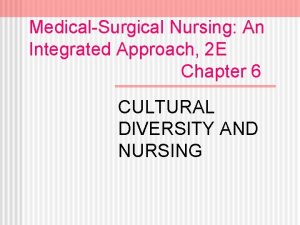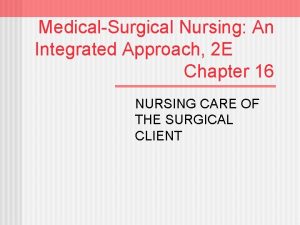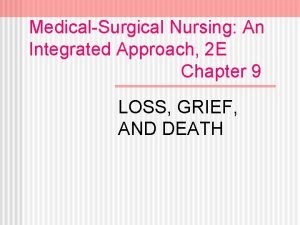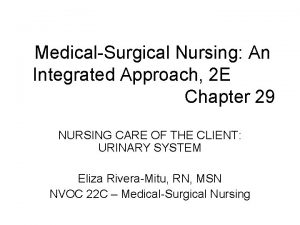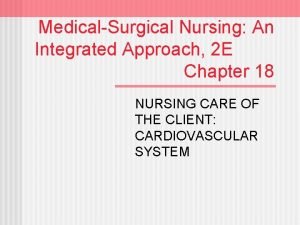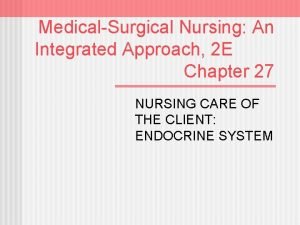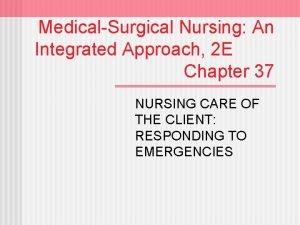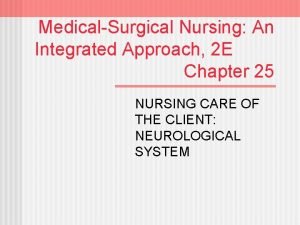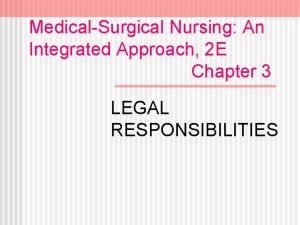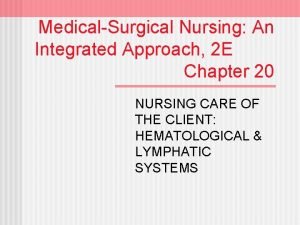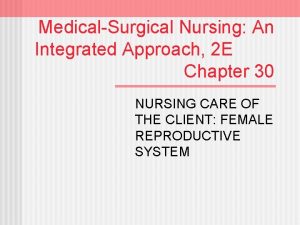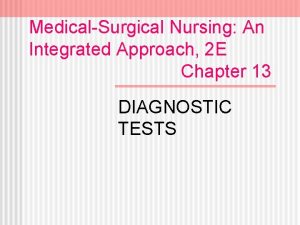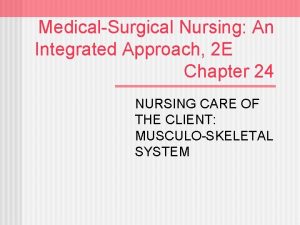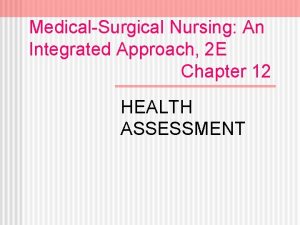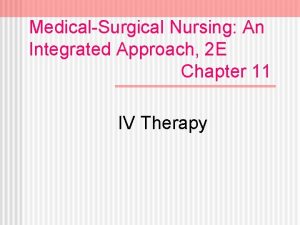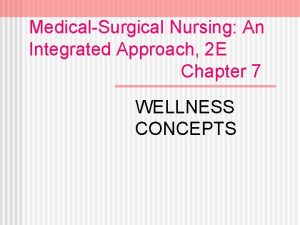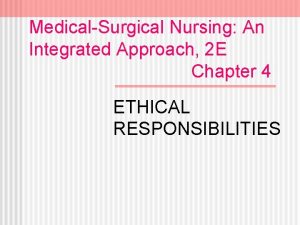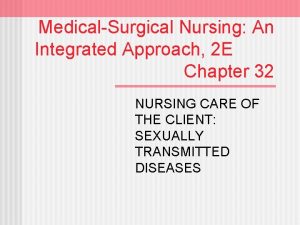MedicalSurgical Nursing An Integrated Approach 2 E Chapter


































- Slides: 34

Medical-Surgical Nursing: An Integrated Approach, 2 E Chapter 18 NURSING CARE OF THE CLIENT: RESPIRATORY SYSTEM

Respiratory System n Its primary function is delivery of oxygen to the lungs and removal of carbon dioxide from the lungs.

Thoracic Cavity The inside of the chest cage is called the thoracic cavity. n Contained within the thoracic cavity are the lungs, cone-shaped, porous organs encased in the pleura, a thin, transparent double-layered serous membrane lining the thoracic cavity. n

The Physiology of the Lungs The right lung is larger than the left and is divided into three sections or lobes: upper, middle, and lower. n The left lung is divided into two lobes: upper and lower. n The upper portion of the lungs is the apex; the lower portion is the base. n

Conducting Airways The conducting airways are tubelike structures that provide a passageway for air as it travels to the lungs. n The conducting airways include the nasal passages, mouth, pharynx, larynx, trachea, bronchi, and bronchioles. n

Pharynx n The conducting airways that connect nasal passages and mouth to the lower parts of the respiratory tract.

Larynx n The passageway for air entering and leaving the trachea and containing the vocal cords.

Trachea n Commonly known as the windpipe, this tube is composed of connective tissue mucosa and smooth muscle supported by C-shaped rings of cartilage.

Bronchi n Two tubes, the right and left primary bronchi, that each pass into its respective lung.

Bronchioles n Within the lungs, the bronchi branch off into increasingly smaller diameter tubes until they become the terminal bronchioles.

Respiration A process of gas exchange necessary to supply cells with oxygen for carrying on metabolism, and to remove carbon dioxide produced as a waste by-product. n Two types of respiration: external and internal. n

External Respiration n The exchange of gases between the inhaled air and the blood in the pulmonary capillaries.

Internal Respiration n The exchange of gases at the cellular level between tissue cells and blood in systemic capillaries.

Assessment

Adventitious Breath Sounds Abnormal sounds and some conditions associated with them: n n n Fine crackles (dry, highpitched popping…COPD, CHF, pneumonia) Coarse crackles (moist, low-pitched gurgling…pneumonia, edema, bronchitis) Sonorous wheezes (lowpitched snoring…asthma, bronchitis, tumor) n n n Sibilant wheezes (highpitched, musical … asthma, bronchitis, emphysema, tumor) Pleural friction rub (creaking, grating… pleurisy, tuberculosis, abscess, pneumonia) Stridor (crowing…croup, foreign body obstruction, large airway tumor).

Common Diagnostic Tests for Respiratory Disorders n n n Laboratory Tests (Hemoglobin; Arterial blood gases; Pulmonary Function Tests; Sputum Analysis). Radiologic Studies (Chest X-ray; Ventilationperfusion scan; CAT scan; Pulmonary angiography). Other (Pulse oximetry; Bronchoscopy; Thoracentesis; MRI).

Upper Respiratory Tract Infections/Inflammatory Disorders n n n Rhinitis (coryza, common cold) Allergic rhinitis Sinusitis n n n Pharyngitis Tonsillitis Laryngitis

Pneumonia A lung infection wherein infectious secretions accumulate in the air passages and interfere with gas exchange. n Clients with chronic pulmonary disorders or problems of immobility are at increased risk of developing pneumonia. n

Tuberculosis Pulmonary TB is an infection of the lung tissue caused by the Mycobacterium tuberculosis. n Treatment of TB requires the long-term administration of pharmacological agents. n

Pleurisy/Pleural Effusion Pleurisy is a painful condition that arises from inflammation of the pleura, or sac that encases the lung. n Pleural effusion occurs when the inflamed pleura secretes increased amounts of pleural fluid into the pleural cavity. n

Atelectasis A common respiratory tract disorder associated with immobility and the administration of anesthetic agents. n Clients at risk are encouraged to cough and breathe deeply to aid in preventing atelectasis. n

Pulmonary Embolism Obstruction of a pulmonary artery by a bloodborne substance. n Deep vein thrombosis is a common cause of pulmonary embolism. n

Pulmonary Edema A life-threatening condition characterized by a rapid shift of fluid from plasma into the pulmonary interstitial tissue and the aveoli, resulting in markedly impaired gas exchange. n Can result from severe left ventrical failure, rapid administration of I. v. fluids, inhalation of noxious gases, or opiate or barbiturate overdose. n

Adult Respiratory Distress Syndrome A life-threatening condition characterized by severe dyspnea, hypoxemia, and diffuse pulmonary edema. n Usually follows major assault on multiple body systems or severe lung trauma. n

Acute Respiratory Failure Conditions wherein there is a failure of the respiratory system as a whole. n This condition occurs as a result of the client’s literally becoming too tired to continue the “work” of breathing. n

Chronic Obstructive Pulmonary Disease A collective term used to refer to chronic lung disorders wherein air flow into or out of the lungs is limited. n Disorders associated with COPD are asthma, chronic bronchitis, emphysema, and bronchiectasis. n

Asthma n A condition characterized by intermittent airway obstruction in response to a variety of stimuli.

Bronchitis n An inflammation of the bronchial tree accompanied by hypersecretion of mucus.

Emphysema n A complex and destructive lung disease wherein air accumulates in the tissues of the lungs.

Bronchiectasis A chronic dilation of the bronchi. n Main causes of this disorder are pulmonary TB infection, chronic upper respiratory tract infections, and complications of other respiratory disorders of childhood, particularly cystic fibrosis. n

Pneumothorax/Hemothorax n Traumatic disorders of the respiratory tract wherein the underlying lung tissue is compressed and eventually collapses.

Neoplasms of the Respiratory Tract Benign neoplasms. n Lung cancer. n Cancer of the larynx. n

Epistaxis A hemorrhage of the nares or nostrils. n May be unilateral (most common) or bilateral. n Blood loss can be minimal to severe. n

Smoking n Cigarette smoking is indicated as a major causative factor in the development of respiratory disorders, such as lung cancer, cancer of the larynx, emphysema, and chronic bronchitis.
 An integrated approach to business studies
An integrated approach to business studies Biol 2420 lone star college
Biol 2420 lone star college Integrated nursing pathway
Integrated nursing pathway Difference between datagram and virtual circuit
Difference between datagram and virtual circuit Cognitive approach vs behavioral approach
Cognitive approach vs behavioral approach Waterfall and shower approach
Waterfall and shower approach Multiple approach avoidance
Multiple approach avoidance Cognitive approach vs behavioral approach
Cognitive approach vs behavioral approach Research approach meaning
Research approach meaning Traditional approach vs object oriented approach
Traditional approach vs object oriented approach Tony wagner's seven survival skills
Tony wagner's seven survival skills Subjective vs objective data
Subjective vs objective data Chapter 16 nursing assessment
Chapter 16 nursing assessment Nursing a concept based approach to learning volume 2
Nursing a concept based approach to learning volume 2 Nursing a concept based approach to learning
Nursing a concept based approach to learning Nursing a concept based approach to learning
Nursing a concept based approach to learning Team nursing method
Team nursing method Nursing intervention for ocd
Nursing intervention for ocd Nursing care plan cataract
Nursing care plan cataract Mental health nursing process
Mental health nursing process Nursing process in psychiatric nursing
Nursing process in psychiatric nursing Is chalk natural or manmade
Is chalk natural or manmade The selection of a research approach creswell
The selection of a research approach creswell Nursing chapter 1
Nursing chapter 1 Chapter 7 nursing management of pain during labor and birth
Chapter 7 nursing management of pain during labor and birth Chapter 41 rehabilitation and restorative nursing care
Chapter 41 rehabilitation and restorative nursing care Chapter 14 nursing management during labor and birth
Chapter 14 nursing management during labor and birth Nursing management preoperative care
Nursing management preoperative care Pie charting nursing examples
Pie charting nursing examples Kataoka-yahiro and saylor's model
Kataoka-yahiro and saylor's model Human flourishing nursing examples
Human flourishing nursing examples Chapter 17 fundamentals of nursing
Chapter 17 fundamentals of nursing Legal dimensions of nursing practice
Legal dimensions of nursing practice Chapter 5 assisting with the nursing process
Chapter 5 assisting with the nursing process Chapter 2 legal and ethical aspects of nursing
Chapter 2 legal and ethical aspects of nursing











